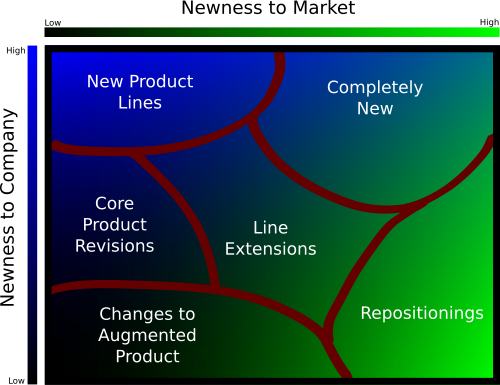Marketing/Product Development
CH.1-Introduction CH.2-Marketing Strategy CH.3-Marketing Plan CH.4-Targeting & Segmentation
CH.5-Consumer Behavior CH.6-Product Development CH.7-Market Research CH.8-Marketing Ethics
| “ | My experience has been that creating a compelling new technology is so much harder than you think it will be that you're almost dead when you get to the other shore. | ” |
Introduction
[edit | edit source]In business and engineering, new product development (NPD) is the term used to describe the complete process of bringing a new product or service to market. There are two parallel paths involved in the NPD process : one involves the idea generation, product design, and detail engineering ; the other involves market research and marketing analysis. Companies typically see new product development as the first stage in generating and commercializing new products within the overall strategic process of product life cycle management used to maintain or grow their market share.
Types of new products
[edit | edit source]There are several general categories of new products. Some are new to the market (ex. DVD players into the home movie market), some are new to the company (ex. Game consoles for Sony), some are completely novel and create totally new markets (ex. the airline industry). When viewed against a different criteria, some new product concepts are merely minor modifications of existing products while some are completely innovative to the company. These different characterizations are displayed in the following diagram.
The process
[edit | edit source]There are several stages in the new product development process...not always followed in order:
- Idea Generation (The "fuzzy front end" of the NPD process, see below)
- ideas for new products can be obtained from customers (employing user innovation), the company's R&D department, competitors, focus groups, employees, salespeople, corporate spys, trade shows, or through a policy of Open Innovation
- formal idea generating techniques include attribute listing, forced relationships, brainstorming, morphological analysis, problem analysis
- Idea Screening
- the object is to eliminate unsound concepts prior to devoting resources to them.
- the screeners must ask at least three questions:
- will the customer in the target market benefit from the product?
- is it technically feasible to manufacture the product?
- will the product be profitable when manufactured and delivered to the customer at the target price?
- Concept Development and Testing
- develop the marketing and engineering details
- who is the target market and who is the decision maker in the purchasing process?
- what product features must the product incorporate?
- what benefits will the product provide?
- how will consumers react to the product?
- how will the product be produced most cost effectively?
- prove feasibility through virtual computer aided rendering, and rapid prototyping
- what will it cost to produce it?
- test the concept by asking a sample of prospective customers what they think of the idea
- develop the marketing and engineering details
- Business Analysis
- estimate likely selling price based upon competition and customer feedback
- estimate sales volume based upon size of market
- estimate profitability and break even point
- Beta Testing and Market Testing
- produce a physical prototype or mock-up
- test the product in typical usage situations
- conduct focus group customer interviews or introduce at trade show
- make adjustments where necessary
- produce an initial run of the product and sell it in a test market area to determine customer acceptance
- Technical Implementation
- New program initiation
- Resource estimation
- Requirement publication
- Engineering operations planning
- Department scheduling
- Supplier collaboration
- Resource plan publication
- Program review and monitoring
- Contingencies - what-if planning
- Commercialization (often considered post-NPD)
- launch the product
- produce and place advertising and other promotions
- fill the distribution (business) pipeline with product
- critical path analysis is most useful at this stage
Recap
[edit | edit source]These steps may be iterated as needed. Some steps may be eliminated. To reduce the time that the NPD process takes, many companies are completing several steps at the same time (referred to as concurrent engineering or time to market). Most industry leaders see new product development as a proactive process where resources are allocated to identify market changes and seize upon new product opportunities before they occur (in contrast to a reactive strategy in which nothing is done until problems occur or the competitor introduces an innovation). Many industry leaders see new product development as an ongoing process (referred to as continuous development) in which the entire organization is always looking for opportunities.
For the more innovative products indicated on the diagram above, great amounts of uncertainty and change may exist, which makes it difficult or impossible to plan the complete project before starting it. In this case, a more flexible approach may be advisable.
Because the NPD process typically requires both engineering and marketing expertise, cross-functional teams are a common way of organizing projects. The team is responsible for all aspects of the project, from initial idea generation to final commercialization, and they usually report to senior management (often to a vice president or Program Manager). In those industries where products are technically complex, development research is typically expensive, and product life cycles are relatively short, strategic alliances among several organizations helps to spread the costs, provide access to a wider skill sets, and speeds the overall process.
